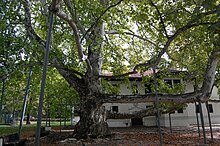Platanus × acerifolia
From Wikipedia, the free encyclopedia
| Platanus × acerifolia | |
|---|---|
 |
|
| London plane seed ball | |
| Scientific classification | |
| Kingdom: | Plantae |
| (unranked): | Angiosperms |
| (unranked): | Eudicots |
| Order: | Proteales |
| Family: | Platanaceae |
| Genus: | Platanus |
| Species: | P. × acerifolia |
| Binomial name | |
| Platanus × acerifolia (Aiton) Willd. |
|
| Synonyms[1] | |
|
|
Contents
Description
London plane in NMSU
It shares many visual similarities with Platanus occidentalis (American sycamore), of which it is derived; however, the two species are relatively easy to distinguish, considering the London plane is almost exclusively planted in urban habitats, while P. occidentalis is most commonly found growing in lowlands and alluvial soils along streams.[3]
Origin
London plane in Whittier College
Controlled reciprocal pollinations between P. occidentalis and P. orientalis resulted in good yields of germinable seed and true hybrid seedlings. Crosses of both species, as females, with P. racemosa and P. wrightii produced extremely low yields of germinable seed, but true hybrids were obtained from all interspecific combinations. Apomixis (asexual reproduction from non-fertilized seeds) appeared common in P. orientalis.[6]
In 1968 and 1970, Frank S. Santamour, Jr., recreated the P. orientalis, P. occidentalis cross using a P. orientalis of Turkish origin with American sycamores (P. occidentalis). The offspring were evaluated following several years of exposure to anthracnose infection. Two selections, 'Columbia' and 'Liberty', were released in August, 1984.[6][7]
Leaves
The London Planetree has alternate leaf mosaic, lobed leaf shape, palmate leaf venation, and dentate leaf margins.Taxonomy
This example, Topčider Park, Belgrade, was planted in 1834
Cultivation
Foliage close-up seen near Westminster Abbey
Platanus × acerifolia
Platanus x hispanica - MHNT
| Stereo image
|
||
|
||
|
||
|
||
|
||
| Avenue of London plane trees on Jesus Green. |
The London plane is very tolerant of atmospheric pollution and root compaction, and for this reason it is a popular urban roadside tree. It is now extensively cultivated in most temperate latitudes as an ornamental and parkland tree, and is a commonly planted tree in cities throughout the temperate regions of the world, in London and many other cities.[4] It has a greater degree of winter cold tolerance than P. orientalis, and is less susceptible to anthracnose disease than P. occidentalis. The tree has gained the Royal Horticultural Society of Great Britain's Award of Garden Merit.[15]
The tree is fairly wind-resistant. However, it has a number of problems in urban use, most notably the short, stiff hairs shed by the young leaves and the dispersing seeds; these are an irritant if breathed in, and can exacerbate breathing difficulties for people with asthma. The large leaves can create a disposal problem in cities. These leaves are tough and sometimes can take more than one year to break down if they remain whole.
London planes are often pruned by a technique called pollarding. A pollarded tree has a drastically different appearance than an unpruned tree, being much shorter with stunted, club-like branches. Although pollarding requires frequent maintenance (the trees must usually be repruned every year), it creates a distinctive shape that is often sought after in plazas, main streets, and other urban areas.
In New York City
According to the New York City Department of Parks and Recreation the symbol of that organization is a cross between the leaf of the London plane and a maple leaf. It is prominently featured on signs and buildings in public parks across the city. The tree is on the NYC Parks Department's list of restricted use species for street tree planting because it constitutes more than 10% of all street trees.In Australia
In Australia, the London plane is used extensively as a street tree in major cities, particularly Sydney, Melbourne and Adelaide. The tree is commonly used because of its resilience to warm weather, its benefits as a shade tree, resistance to breakage and tolerance of urban pollution.Timber
When quarter-sawn the timber has a distinctive and highly decorative appearance of dark reddish-brown flecks against a lighter background and is known as Lacewood.[16]Cultivars and varieties
A house finch eating London plane seeds in Seattle
London plane (Platanus × acerifolia) - note single seed ball per stem: similar to P. occidentalis, not found in all clones
- Augustine Henry. This is a tall growing variety, with very large, pale green leaves. It produces a strong leader and a cylindrical trunk.[6]
- Bloodgood, This is one of the first cultivars to be selected for anthracnose resistance. It is a rounded tree with deep green leaves that turn a poor yellow in fall. The plant tolerates poor cultural conditions, including heat, drought and poor soil. Recent observations indicate susceptibility to ozone.
- Columbia. Resists mildew and anthracnose, this tree has deeply lobed, dark green leaves.[17]
- Liberty. A U.S. National Arboretum introduction, this pyramidal tree grows vigorously. It shows good tolerance for mildew, anthracnose, heat and drought.[17]
- Metzam (Metroshade), A new introduction that grows strongly with a pyramidal habit, this cultivar is also said to be disease resistant with lustrous green foliage that emerges with a reddish cast.[17]
- Mirkovec. Has a dwarf, shrubby habit and unusual variegated lobed leaves with pink, cream and bronze regions.[17]
- Pyramidalis. A cultivar or cultivar group common in London, with rich glossy green leaves, and a characteristic tendency to produce straight branches, compared to sinuous ones in other forms.[6]
- Suttneri. Leaves are variegated creamy white.
- Yarwood. Very resistant to powdery mildew and highly susceptible to anthracnose. Poor structure. Being abandoned in California.[18]








